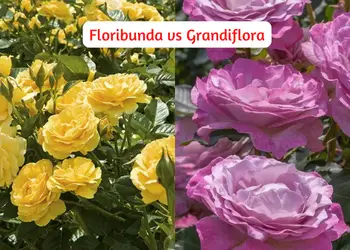Two popular rose varieties you will find are floribunda and grandiflora. So here I’m comparing the two head-to-head – floribunda vs grandiflora.
I’ll go over the main differences in appearance, special characteristics, blooming, pests, sun and water needs, and where you might look to use each type
While they may look similar at first glance, there are some key distinctions between these two rose varieties. Here’s a quick summary.
Floribundas are compact bushes, with smaller clusters of blooms, are more heat tolerant, and are less disease resistant than grandiflora, which are typically taller, with mostly single stems, and large ‘grand’ blooms that are sometimes double blooms. Both bloom in flushes throughout the season.
So that’s the basic overview, but there’s lots more to know when comparing floribunda vs grandiflora. So let’s get into more detail about each type.
Floribunda vs Grandiflora
So here it is, floribunda vs grandiflora. We’ll start by expanding on their size and shape. You can find out more about each of these roses in the links below…
Size and shape
Their size and overall shape are the first things you’ll notice when you compare floribunda and grandiflora roses.
Floribundas are typically smaller bushes, typically growing to about three feet tall. While grandifloras tend to grow taller and larger up to around six feet.
Their stems are also different. Floribunda rose stems are typically shorter and thicker while grandiflora stems are longer and thinner.
The size difference is due to the different ways these roses are bred. This cultivation of difference in size and shape is mainly due to the fact that grandifloras are a hybrid of floribundas and Hybrid Teas, while floribunda is a cross between Hybrid Teas and Polyanthas.
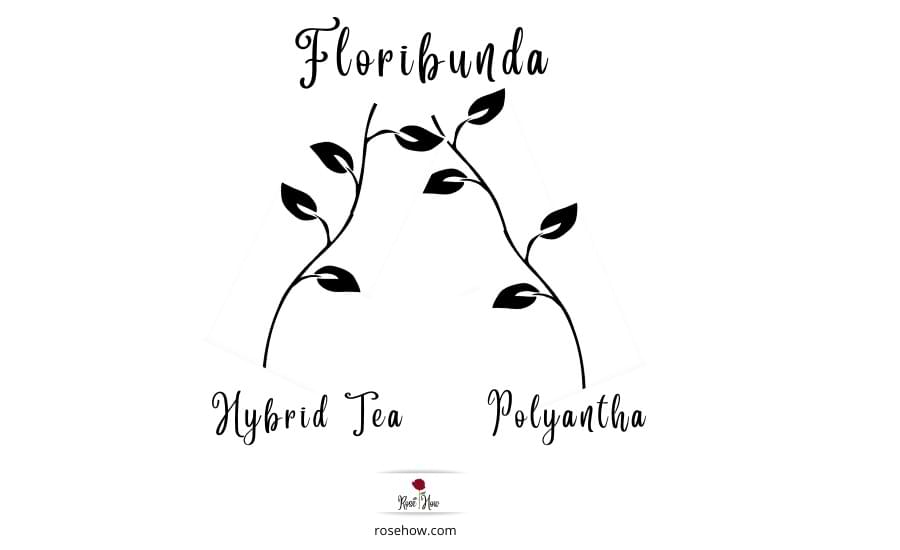

The flowers of grandifloras are typically larger than floribunda roses. The blooms of a floribunda rose are more likely to be clustered together in small groups, while grandiflora roses will have fewer blooms that are larger.
Floribundas are bred for quantity, with the aim of producing lots of smaller blooms, while grandifloras are bred for quality, resulting in fewer but larger flowers.
Flowers
The blooms on a floribunda are generally smaller than those of a grandiflora, which can be as large as a small dining plate at times. But there are more blooms on a floribunda.
Tip: To help remember which is which, I think of them in terms of their meanings. Grand-flora as referring to the larger size of the bloom, and Flora-abundant as referring to the cluster of smaller blooms on a floribunda.
Floribundas may have either single or semi-double blooms, but most are single. And these can be either cup-shaped or lower profile and flat.
Grandifloras usually have double blooms that are flatter than a floribunda’s.
Number of petals
Another difference between these two types is the number of petals. Floribunda single flowers will have an average of 5-12 petals, while grandifloras will have around 5-6 petals.
Color
There is a wealth of color choices with floribunda vs grandiflora. Both are available in a range of different colors – red, pink, yellow, white, and even purple. There are even new dual-color varieties.
Hardiness
Floribundas are quite hardy and able to grow in USDA zones 4-11 generally speaking. Grandifloras are not quite as hardy and are grown best in USDA zones 6-10.
Floribundas tend to cope with winters and cold climates a little better than grandifloras.
Sunshine requirements
Both floribundas and grandifloras need at least six hours of sunlight each day in order to thrive, although they will both tolerate partial shade.

Pruning requirements
The pruning requirements for floribundas and grandifloras are also different. Floribundas require very little pruning, and can even be left to grow largely unchecked.
Grandifloras, on the other hand, require regular pruning in order to produce the best ‘single’ blooms.
Water needs
Both floribundas and grandifloras need to be watered regularly, although grandifloras require slightly more water than floribundas. I guess it takes a lot of effort to grow blooms that size.
If you want to water your roses the best way, then read this guide on watering roses.
Soil requirements
The soil requirements for floribundas and grandifloras are also different. Floribundas prefer loamy soil, while grandifloras prefer soil that is perhaps just slightly more sandy.
Pest and disease resistance
Generally speaking, floribundas are more resistant to pests and diseases than grandifloras.
However, both types of roses are susceptible to blackspot and powdery mildew, so regular spraying is necessary to keep these problems at bay.
Planting
When it comes to planting and spacing, the grandifloras need more height than floribundas, so plant them about 3 feet apart.
Floribundas only grow to be about 2-3 feet tall, so you can plant them closer together (about 18 inches apart).
Summary information
Here’s a summary of the information, then we’ll move on to the best uses.
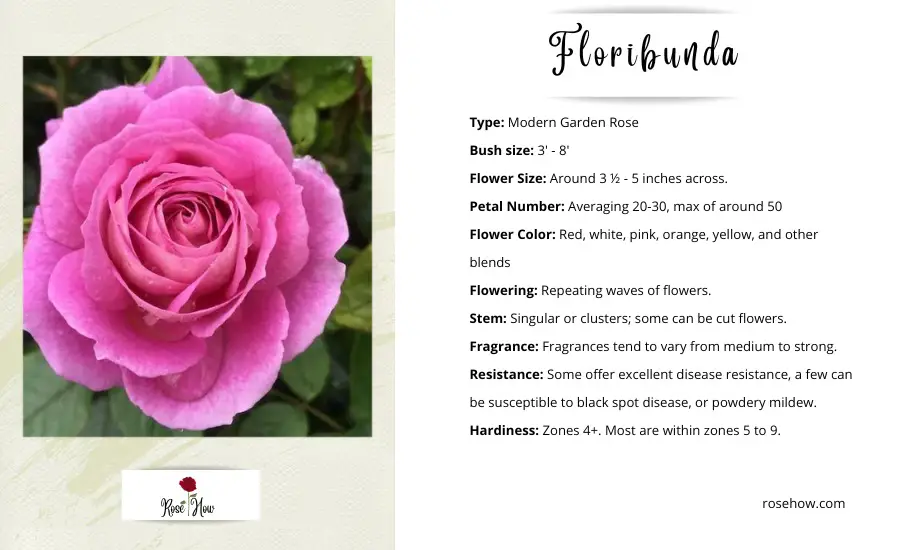
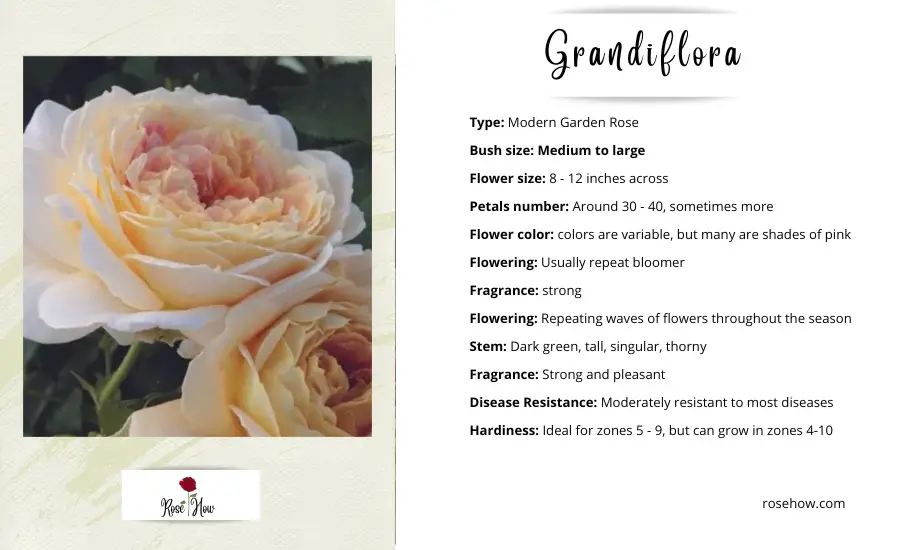
You can explore more about the categories of roses here. Or find more information about the types of roses.
Floribunda vs Grandiflora – Best uses
As I mentioned earlier, a grandiflora will grow taller than a floribunda.
So, if you are looking to line your driveway with roses, go with the grandifloras. They’re also good as a rear layer of flowers for your beds.
If you have a smaller garden or need more groundcover, and a greater array of flowers, then floribundas are probably a better choice.
If you are looking for a rose with more impact, go with a grandiflora.
Why not have both, floribundas around the border – or mid-border, and grandifloras as a rear layer to your beds?
If you’re looking for widespread and fuller coverage, then you might simply prefer a rose shrub. Just keep in mind the height of shrub rose bushes can vary, so choose carefully before you buy.
So, which is better? It really depends on what you are looking for. If you need a rose for impact, go with grandiflora.
If you want more groundcover or an array of flowers, then floribunda is the way to go.
Floribunda vs Grandiflora: Typical types
Looking to grow some of these? Well here are a few popular types that gardeners like to grow.
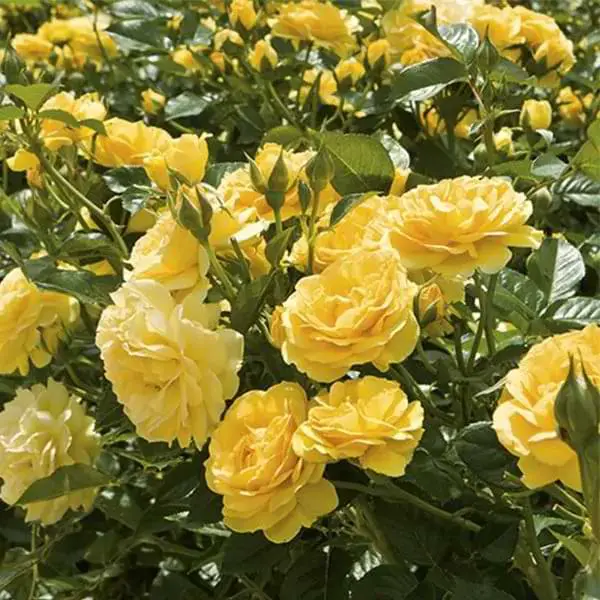
Floribunda
Go for the one that most people consider the classic floribunda
Julia Child Rose
- Grows to around 3 feet tall
- Mild yellow color
- Repeat blooms throughout the season
- Ideal from growing zone 5b
- Has a licorice scent to it
Grandiflora
For grandifloras, consider growing this one for starters
Nicole Carol Miller™ Rose
- Matures at around 4 – 6 feet high and 3 -4 feet wide
- Stunning lavender to lavender/white color
- Growing zone 6 – 9

Floribunda vs Grandiflora ~ More roses help 🌹
I hope this has given you a great overview of floribunda vs grandiflora and provided a couple of options to try out. Be sure to check out my other rose-growing articles.
Also, check out my recommended tools and resources for more rose help!
Happy rose growing! 🌹
Rose Categories, Modern, Old Garden, and Wild, Ultimate Guide

Hi, I’m Michael. My passion for roses was sparked a few years ago after visiting a dedicated community rose garden. So Rosehow.com represents my take, my learnings, and my help for anyone looking to grow, be proud of, and harvest roses.

